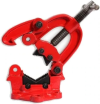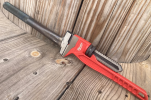To make more layers, most folks cut and restack it. Start with 10 layers, draw it out to about 3/8" thick, grind the surfaces clean, cut into 5 pieces. Re-stack and weld up into 50 layers. Draw out/cut/restack again and you have 250 layers. Now you have a random billet that you can make a knife from. Damascus patterns show bet in the 200–500-layer range.
When handmaking damascus in the forge, I often use a simpler method I call "Always Red". Jim Batson and I demonstrated it 25 years or so ago at one of Bill Moran's hammer-ins in Fredrick, MD:
1) Metal - Start with a reasonable number of layers to hand weld. 7 works well - 4 layers of 1084 and 3 layers of 15N20 is my go-to stack. For shinier damascus, you reverse those numbers. (If it is your first attempt at damascus, try five layers.)
Cut the metal into even size pieces. I use .25" X1.5 stock and cut 4" long pieces. That stacks to a 1.5X1.75X4" billet which is pretty easy to weld up and draw out by hand.
Another mix that plays well together is O-1 and 1084. This mix makes a less defined and more "antique" looking damascus. It looks great at around 500 layers.
2) Billet - Grind all pieces clean on an 80-120 grit belt. If welding up the billet at a later date, store the pieces in a closed box
When ready to make the billet, wash and dry all the pieces with hot water and dish soap and dry with clean paper towels. Clamp the stack in a vise or C-clamp and weld up the four corners and one pass down the sides at the center. Any welder type will work - Stick, MIG, TIG. It does not need to be pretty, but should be a good weld. When welded up, grind one end clean and weld on an 4" handle of 5/8 to 3/4"" rebar. The short handle makes storing in the kerosene tank easier. The beefy size makes it stay on the billet better in forging. Use good welding techniques and chamfer the handle end to increase weld strength.
3) Flux - I use hydrocarbon fluxing for the "Always Red" method - This keeps oxygen away from the inside layers until they are welded solid. Borax flux is used sparingly later on.
As soon as the billet corners/sides and handle are welded up and it cools off, put the billet in a can of kerosene with a lid. You can make up as many billets as you want and store them in a covered Kero-can until you want to forge weld one or more (an old ammo can works perfect). They can sit there for years with no oxidation or rust. When ready to weld up, take out a billet and let the excess kerosene drain off, then place immediately in the forge. The remainder will burn off quickly and leave a carbon residue to remove oxygen from the inside surfaces to be welded. It makes very good welds this way.
4) Forging - When ready to forge weld the billet by the "Always Red" method, you won't stop for a while, so have everything ready, and have a friend to help and spell you if needed.
Grip the billet by the handle with "V" bit tongs or RR-spike tongs. This gives a nice solid grip and makes welding and turning easier.
The trick to solid forge welds is using less flux and keeping scale from forming on the billet. The major way to do that is to never let the billet get below a nice bright cherry red color. Do short forging heats, brush off the surfaces, and stick it back in the forge often. This also make for easier forging because 2300° metal works much easier under the hammer than 1600° metal. In this method of forge welding and stacking, NEVER let the billet get dark red or black. If you do you will have scale form.
The other thing that causes bad forge welds is rushing things. Steel won't weld well until it is at the right temperature. Hitting it harder or pouring on more flux won't replace the proper temperature in welding by hand.
I start welds with a 1.5#/1Kg hammer. You don't want a heavy hammer to start with.
Note - One thing to always do is wipe off the anvil face each time you finish a heat. Scale and flux on the anvil are a major cause of inclusions.
Heat the billet in the forge (preferably a propane forge) to welding heat, around 2300°F, and let fully soak so it is hot all the way through. Adjust the forge to stay at this temperature. You want a neutral flame to a slightly reducing flame with just a bit of yellow in the dragon's breath. Heat control and making sure the entire billet is at welding heat inside and out assures a perfect weld.
A trick to know when the billet is at welding heat is to take a straightened-out coat hanger wire and poke the billet. Heat the end a bit and stick in the can of borax flux. Stick it in the forge and push/rub on the billet. If it is at welding heat, the coat hanger will stick to it. Give it a twist and pull it off if it sticks. If it doesn't stick, the billet isn't hot enough yet. The billet is ready to set the weld when it looks the right color (white hot just past yellow) and the wire sticks to it.
Take out and quickly brush off quickly with a stiff wire welding brush. Put immediately back for a minute to rebound to white hot and pull out to set the weld. Use medium soft blows and let the metal fuse by light pressure and heat. Do this for about 10-15 seconds (keeping it in the full cherry-red color). Don't let the billet cool down any more than needed. When you pull the billet for the next hammering, give a quick brush off and immediately set the welds again. Repeat the set welds two or three more times, adding more power to your hammer as you get it welded. The sound will change from a duller "thud" to a more solid sound as it welds up. I try to do the first two welds at full white heat and then do the next two at lesser heats down into the yellow range. Warning - If you try to smash the steel together with hard hammer blows you may mush the billet apart and ruin it. Once welded up solid work the billet all around again to make sure. The billet should end up roughly 1.5" square and 4" long. You should not be seeing distinct lines down the sides when fully welded up. At this point you can take a break and let the billet cool off. Once cool, grind all the sides clean and look it over well to make sure it is a solid weld. Drink a bottle of water and give your arm a rest for a while.
Turn down the forge a tad so the billet stays in the yellow-white range for the drawing out stages. You don't want to be hammering hard on a white-hot billet.
Clean up the billet on the grinder or with an angle grinder and put in the forge to heat up. Brush off as it gets to yellow. From here on we will use a little borax flux. I said a little because most new smiths use about 10 times the needed flux. It isn't glue and adding more will not make a bad weld suddenly a good weld. The right heat and forging technique are what makes solid welds.
You can switch to a heavier cross-pein hammer now. I use a 3#/2Kg Hofi hammer for drawing out the billets. No need for a huge 4# or heavier hammer unless you like sore arms.
Re-heat the billet and let soak a bit to assure it is hot all the way to the middle. Take out, brush off, and start drawing it out. When it drops to cherry red, brush off, sprinkle a light dusting of borax, brush off again, and put back to re-heat. Don't try to draw any more than what can be done in these short hot heats. You will be surprised at how fast and easier the billet draws out at the right heat. When ready for the next draw, pull out, brush off, sprinkle a light dusting of borax, brush off again, draw out more. Do this until the billet is 10-12" long, fairly straight and flat. Lightly flux again and put back in the forge. Drop the hot cut in the hardie. When hot again, take out and use the hot cut to cut 3/4 the way through at the center. Quickly brush off the uncut side, sprinkle a light dusting of borax, brush off, and then hinge-fold the bar back on itself, tapping it flat and straight together. Immediately stick back in the forge. DON'T let it cool of any more than necessary. Pull from the forge and repeat setting the weld as needed to get it solidly welded - Usually about three heats. Use flux sparingly along te seam, if at all, and brush away excess flux. When the weld is solid, draw it out as earlier and the repeat folding. You want to do the drawing and folding as a continuous process that never lets the bar get below cherry red. It gets fast as you get the rhythm donw. With a friend helping, you can do it in an hour or two.
The layer count build pretty fast, and six folds give a very nice damascus billet: 7-14-28-56-112-224-528. If you start with five layers: 5-10-20-40-80=160=320
When done with the final fold, draw the billet out to about 1/8" thicker than whatever thickness you need. Grind it clean on all sides ... and you will have a nice bar of damascus. I usually end up with a 16" bar around 1.25" wide and 3/8" thick. I can forge two nice size knives from that.
I have to split this into two posts.......


